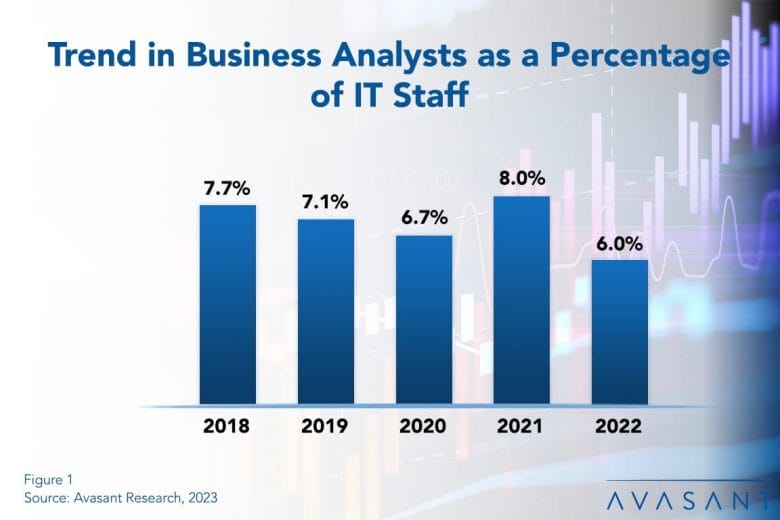The business analyst staffing ratio appears to be declining, but the role is not falling in importance. Business analyst staff is as important as ever. But the reporting relationship has been increasingly shifting from the IT department to user departments. Business analysts sit between the IT organization and the business, it has always been a bridge between the two. Therefore, as business users become more IT-savvy, it is only natural that business analysts would increasingly be rising up within the business rather than in the IT organization.
As shown in Figure 1 from our full report, Business Analyst Staffing Ratios, after a quick increase to 8.0% of IT staff at the median in 2021, the ratio declined to 6.0% in 2022, reverting to its previous downward trend.

In recent years, we have predicted that the business analyst role would continue to rise in prominence within IT organizations. The IT staffing mix, we argued, is changing as the cloud transformation continues in earnest, and the IT organization should play a leading role in the digital transformation of the business.
Regardless of their reporting relationship, business analysts are pivotal in the era of digital transformation. They help navigate the organization along its IT strategy road map. A business analyst not only defines the process of digital transformation but has a clear understanding of the needs of the business as well as the capabilities of the IT organization. Without business analysts, the IT organization will have difficulty aligning with the business—and the business will have difficulty articulating its needs to the IT organization.
At most businesses, digital transformation has progressed beyond the mere digitalization of analog processes. Most companies are now reimagining business processes from the ground up. Business analysts, with one foot firmly in the business and one foot firmly in the IT organization, are best situated to understand the art of the possible. Manual processes are expected to become more efficient by implementing automation and AI. The business analyst will look at the data, tools, and business model to steer the business into a new realm of possibilities.
“The job of the business analyst is almost always industry-specific,” said Tracell Frederick, senior consultant at Avasant, based in Los Angeles. “The industry experience required to serve as a business analyst can make them hard to find. A better solution is to grow them from within, and what better place to find them than within the business units.”
How many business analysts does an organization need? This is a difficult question to answer, as the practice of using business analysts varies widely and is going through some major changes.
The full report provides metrics for benchmarking business analyst staffing levels in the current environment. We look at the trend in business analysts staffing over a five-year period and provide four benchmarks by organization size and sector: business analysts as a percentage of the IT staff, business analysts as a percentage of the delivery group, applications per business analyst, and users per business analyst staff member. We conclude with recommendations on optimizing business analyst staffing levels.
This Research Byte is a brief overview of our report on this subject, Business Analyst Staffing Ratios. The full report is available at no charge for subscribers or it may be purchased by non-clients directly from our website (click for pricing).

